
This game is very challenging – and at first, even the most basic elements are quite foreign. This guide aims to simplify the process of getting into the game, so that new players can pick it up and not feel like they’re fighting against the game’s innovative-but-confusing elements. I won’t spoil all the FUN surprises, but some parts of the game feel like they warrant more in-depth explanations than you get from the game itself. I’m not – yet – a particularly accomplished Soublight explorer, and I still have plenty to learn. This isn’t a definitive “how to win” guide by any means. It’s just a pointer in the right direction.
Contents
Introduction and Basic Stats
All credit goes to obliviondoll!
When I first looked up a video of Soulblight while trying to decide if I wanted to play, one thing struck me. The player – and after watching several videos, the pattern continued – had very little clue how this game actually works. This wasn’t their fault, it was simply that Soulblight doesn’t tell a new player much about how to get started. The basics covered in the tutorial are not clearly or thoroughly explained.
For a roleplaying game, even a fast-paced action-oriented one, Soulblight’s surface layer of stats is extremely light. You have 4 core stats which define the majority of things about your character. You can easily view your character’s “base stats” by opening the stats menu. There are sections in here for Taints, Injuries and Conditions (covered later in this guide) as well as your base stats.
The base stats are those your character has at the start of each adventure, and so far, I’ve seen no way to change any of them permanently. They are altered by your equipment and by other effects. Synergy is listed as a base stat on this page with a description, but there is no base value shown (can reasonably be assumed to be 100% though).
I’m going to work in reverse order, because Synergy is the most important stat in the game. Synergy directly modifies all your abilities. The baseline value is 100%, and it scales up and down as you get modifiers applied through taints and other buffs or debuffs. Most modifiers are temporary, but there are a few effects that can apply lasting synergy buffs to your character.
Mobility is your movement rating, and as such, affects how fast you move around the map. It also adjusts the stamina cost of actions in combat. Keeping this high can let you be more active in combat, but you have to use lighter armour and/or weapons to do it.
Attack and Defense apply directly and exclusively to combat. When you hit someone, your attack value is compared with their defense, and when you take a hit, their attack is compared against your defense. These calculations take a few other factors into account (including synergy modifying both of your values). Each of these stats shows 2 values, one for “distance” and one for “grip”, which will be explained in more detail in the Combat Basics section below.
Stat-Altering Effects
Alongside your basic stats, there are various ways to modify your character’s attributes, as well as some special properties to worry about. Injuries are usually lasting effects, while conditions are usually temporary. Taints can apply both permanent modifiers listed on their own page, and temporary effects which are listed as conditions.
Conditions include time-limited taint buffs/debuffs, as well as special effects from foods or medicinal items you used. Alcohol applied an “intoxicated” effect which temporarily increases synergy (because you feel no pain). It also counteracts the “pain” debuff condition you suffer when treating an injury with low-quality stitching kits. You will often also see players suffering from a “hand numbness” condition which gets applied every time you trigger a bite from a toothy chest.
Injuries effectively act as “lives” within a run. You can only suffer four injuries before you die – each time you run out of health you sustain one injury. The effect is randomised, and can be anything from a concussion, which just goes away if you wait, to a bleeding wound which can inflict further injuries if you leave it untreated. There is a special case with “injuries” inflicted by equipping Black Steel gear. This is a special type of weapon or armour which, while equipped, counts as an injury. It also applied a synergy buff to your character, making you stronger at the cost of one (or more) of your “lives”. These items stack particularly well with the Reckless taint, which gives you a buff based on the number of injuries you’ve sustained.
Many taints also apply a permanent/passive effect, which is noted on the Taints page of the stats menu.
Taint Basics
The above image is a space you pass through regularly during Soulblight gameplay. The white path at the top is *ALWAYS* open. At first, you only have the one path, then another 2 open up, then all 5 paths will be open. The white path leaves you unchanged as a character, while each of the other paths applies the taint it’s labeled with.
You are shown the name of the taint – but not its effects – before you activate the platform and move forward. Once you trigger it, you find out (if you didn’t already know) what your character’s new taint does for you – and to you. Many taints have both positive and negative effects. I’m not going to list them all here, that could be seen as a spoiler (and besides, I haven’t seen them all yet). What I will say is that taking on relevant taints will have a significant impact on your gameplay. A taint will usually give you a passive increase to your synergy, making you just a bit stronger by default. On top of this, there are actions you can take which will give either permanent or temporary additional buffs as a result of any taint you chose. You do, however, need to take care with the taints you choose. Most of them will also offer penalties if you act “out of character”, giving you debuffs instead of a bonus. Avoiding the actions which trigger this situation becomes a balancing act, and you may be tempted to make what would ordinarily be a sub-optimal decision in order to get the best synergy buff from your taint(s).
Combat Basics
Soulblight divides combat into two distinct layers – “distance combat”, which is the more familiar experience for players used to top-down and isometric melee combat, and “grip combat” which has something of a grappling or “clinch” feel to it.
In either combat mode, you have several UI elements to be aware of. There are 2 circles around your character, an outer white ring and an inner ring of green. The white circle is your HP bar, and the green is stamina. When HP is depleted, you don’t immediately die – it triggers a shockwave and resets, but you take an injury (as long as you don’t already have 4). If you’re in grip mode, a blue seciond partially-surrounds your health ring, indicating the arc in which you’ll latch onto an enemy. If you’re not in grip mode, this bar doesn’t appear even if you’ve been gripped by an enemy and are locked into grip combat. Enemies are the same, but without the ability to take injuries – once you deplete their white health bar, they simply die. If you have multiple enemies visible, one target will have their indicators highlighted, while the rest will be slightly faded. The brighter ring indicates your current target – make sure you’re aiming for the right target, especially with thrusting weapons!
As mentioned in the Basic Stats section, your attack and defense values determine what happens when you land – or suffer – an attack. There’s more to it than just this, though. These stats each have two values listed with a slash between them for Distance/Grip. Also, you can charge your attacks to deal more damage, and this also scales up your attack rating, allowing you to stun an opponent with a charged attack where a normal hit wouldn’t do so.
Distance combat is very much about positioning and movement. Dashing is key here. You can bait an enemy to whiff their attack, then dash in to hit them, or swing first, then dash away before getting hit by a counterattack. Blocking still helps, and correctly timing your block to parry attacks will always give an advantage, but you should be focused on spacing more than hunting for the parry every time.
In grip combat, the reverse is true. In place of the dash command, you have a bash which shoves the opponent away violently. This does no damage, and is more of a spacing tool for players who prefer the distance game. You always push gripped enemies directly backwards when you bash, so aligning correctly will let you control where the enemy gets thrown. While engaged in grip combat, parrying is your preferred defensive option. Blocking at the right time isn’t easy, and the timing window shifts based on your loadout, so practice will be important.
In either combat mode, having chrono armour is a huge benefit – when using this armour, you can slow down time in short bursts. This is a powerful advantage for both offensive and defensive play.
When attacking, you can charge up an attack by holding the button down. This turns a section of your (normally green) stamina bar yellow, showing how much of your stamina will be going into the attack. Similarly, while a correctly-timed press of the block button lets you parry, simply holding it down will block attacks and help you to avoid taking damage. Because blocking takes time to initiate, it’s usually preferable to anticipate an attack, pressing and holding the block button before the enemy strikes. Your parry timing will be the beginning of your block, so if you press it too late, you can have the button held down before the enemy hits you, and still eat damage.
Stealth Basics
Stealth is pretty straightforward in Soulblight. Hold the sneak button to sneak, release to move around normally. Wooden bridges will make creaking noises as you sneak across them, but most surfaces allow you to move silently – but sneaking slows you down. I’ve seen a pair of boots with improved sneak speed, but you still move slower than normal movement even with them equipped. While sneaking, you can stealth kill enemies by getting *VERY* close behind them, and hitting the attack button – the game gives you a prompt when you’re in range.
Any time you make noise while sneaking, and when you press or release the sneak button while moving, you see a ring that indicates the distance at which you can be heard. Even if this range doesn’t reach an enemy, you can be detected if they see you – enemy vision arcs are shown as red highlights on the ground in front of them. They are much wider than many dedicated stealth games, almost covering a full 180 degree arc in front of the enemy. This is somewhat balanced by the fact that enemies are horrendously short-sighted, and their vision can be obstructed by terrain and even each other.
Transmutation Basics
I won’t talk much about transmutation, but since there doesn’t appear to be any direct tutorial in the game for how this works, I’ll share a few minor details about how this system works.
Transmutators have two interactions available – looking inside, and using the device to transmutate something. If there is an item in the transmutator, using it will spend essence in an attempt to convert it into a new item. Spending *NO* essence with an item inside will convert the item into an essence item. If you spend essence without an item, you get a piece of candy which can be used to stave off hunger. If you have an item and some essence in the machine when you activate it, something more interesting might happen. Putting essence into a weapon or piece of armour will power it up, giving it a passive synergy buff, or increasing its attack of defense stats. Adding essence to most other items will – if you put enough essence in, or if you get lucky with less – convert them into a better version of the same item. As an example, a simple wire can be upgraded to a primitive lockpick with the addition of some essence.
As of the writing of this guide, Alien has already published a crafting guide which goes into a more detail on the intricacies of the transmutation system, and provides a (growing) list of recipes! I recommend looking that up if you want to know more.
Progression
And, to round out the guide, I’ll cover the basics of what progression means in Soulblight. By default, when you die, you respawn in the starting area with nothing. Nothing at all. You’re unarmed, and have no armour, regardless of how well-equipped you were when you died. There are, however, points in your journey at which you can access a storage chest. If you place items in this chest, there is a storage chest in the starting area which allows you to retrieve those items after death.
As a new player, I’d recommend, where possible, leaving behind a (spare) Chrono Inhibitor armour piece – but only if you have 2 or more by the time you reach the chest. If that isn’t possible, a spare weapon can be a good thing to pass on, since your respawned self will be unarmed. There are a couple of shop NPCs (blacksmith for weapons/armour and shopkeeper for other items), so passing on money can also be a sensible way to set yourself up with a head-start on your next run. The one thing you will always want to do, however, is to put any punch cards you find into storage. These have no use in the dungeon, and can only be read at the starting area. Delivering them to Quara lets you learn more about the game lore, and each one you deliver powers up the “prying” taint, increasing its passive buff.

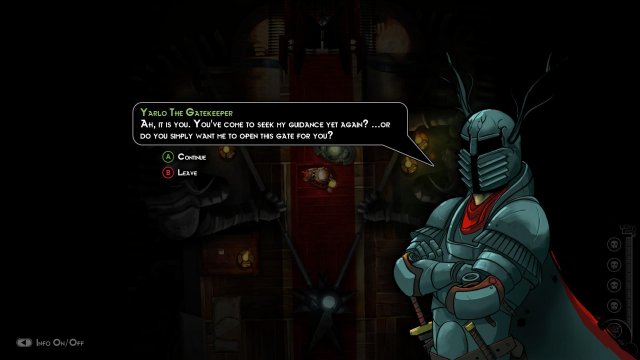
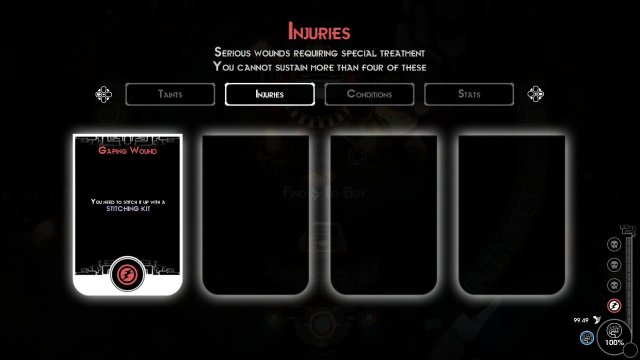
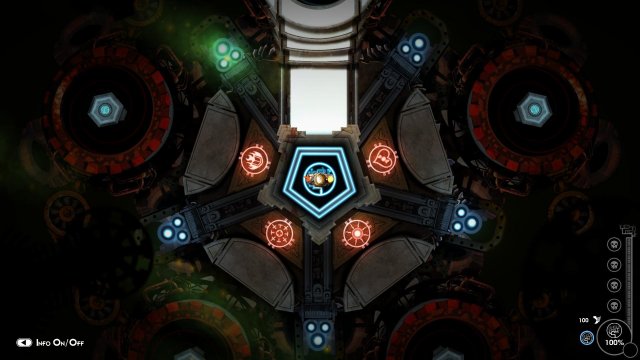
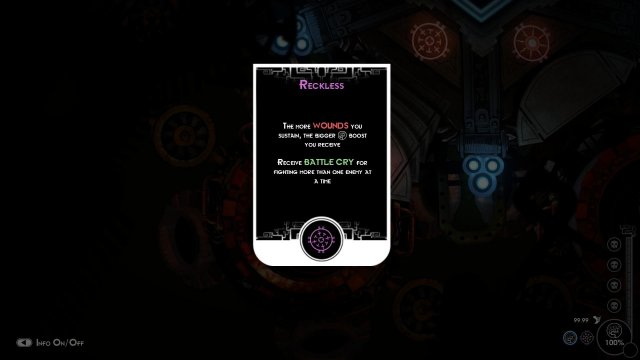
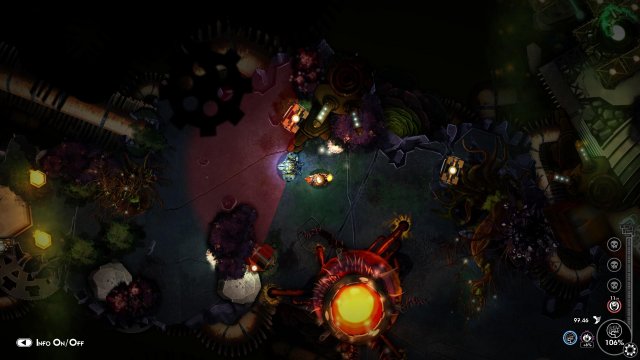
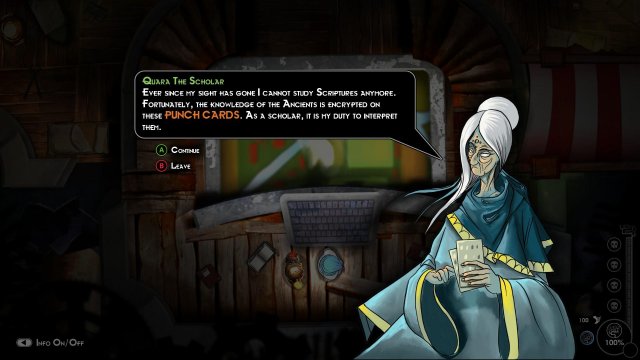

Be the first to comment